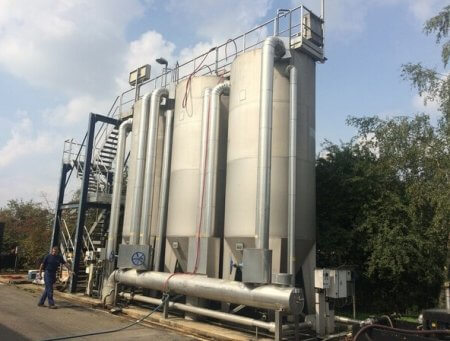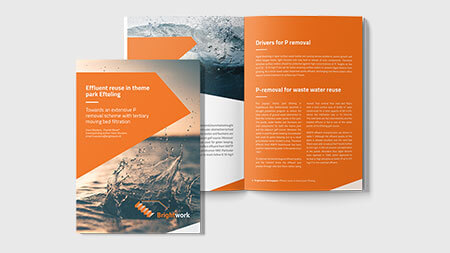Why should we remove phosphorus and how do we do it efficiently?
Why should we remove phosphorus and how do we do it efficiently?
Phosphorus (P) in waste water discharge into a water body is often the limiting nutrient for primary productivity in the water. Hence excessive P may lead to eutrophication.
There has been an increasing demand to achieve very low effluent total phosphorus due to more stringent discharge limits imposed on waste water treatment plants in Europe. Total P levels below 0.10 mg/l require treatment alternatives, well beyond the current technologies.
What phosphorus fractionation is present in waste water effluent?
Secondary effluent of a well performing plant typically contains total phosphorus levels in the range of 0.4 – 1.2. Actual performance depends on the primary and secondary treatment technologies applied. Total phosphorus is a sum parameter, which should be differentiated to analyse the best possible removal method. Phosphorus is present in soluble (pass 0.45 micron filter) and particulate form. Both soluble and particulate phosphorus consist of reactive P (also indicated as ortho P), poly P and organic P. Dissolved organic phosphorus is hard to remove at all and may contribute to 0.05 – 0.2 mg/l. Always be aware of this! You could reach a threshold which is difficult to pass.
What should the additional treatment look like?
If you want to remove phosphorus to say 0.10 mg/l you need to find ways to remove both particulate and soluble phosphorus effectively. Waste water treatment effluent will – per definition – contain both particulate and soluble phosphorus. Samples at Dutch waste water treatment plants show levels of particulate and soluble phosphorus, both in the range of 0.2 – 0.6 mg/l.
Hence the appropriate tertiary treatment technologies should be able to chemically convert the soluble phosphorus and also be an extremely effective barrier for particulate phosphorus by removing solids.

Which technologies are applicable?
We have applied three technologies, which have the power to remove phosphorus to levels less than 0.10 mg/l. Disc and cloth filtration are useful as a compact solution which sometimes might fit nicely into the hydraulic line diagram of the existing treatment plant. Continuous media filtration has also proved to be a very suitable solution for phosphorus removal. It also offers the possibility to combine nitrogen and phosphorus removal in one treatment process. We will always seek for the best possible solution for your case.
Effluent Reuse Theme Park Efteling
The popular theme park Efteling in the south of the Netherlands launched a drought prevention program. In order to reduce the total volume of ground water abstraction to feed the numerous water ponds in the park. Groundwater levels tended to drop as a result of the abstraction. Therefore effluent from waste water treatment plant Kaatsheuvel is used for replenishing water in the ponds. With particular focus to remove phosphorus to levels below 0.10 mg/l total phosphorus to prevent any eutrophication and algae blooming in the ponds.

Download this paper to find out:
How we manage to consistently meet very low total phosphorus levels with continuous tertiary sand filtration.
How the Sand-Cycle monitoring tool continuously contributes to run the plant without any anomalies.
Which results are obtained year-on-year for various parameters, including total phosphorus, suspended solids, BOD, nitrogen.
Testimonials
We are happy to collaborate with our clients to meet their objectives.
And we highly appreciate their feedback!
We are operating a big tertiary filter plant consisting of 24 filter cells to remove nitrogen and phosphorus prior to effluent discharge. The plant is in operation since 2009, and in the beginning we tried to monitor the filters by using an ultrasonic sand circulation measurement tool. This did not work. After Brightwork implemented Sand-Cycle in 2016, this proved to be very useful in our day-to-day operations. We have managed to operate the filters in the most optimal way and we are very happy to use such a powerful tool.
Jan Boonstra
Wetterskip Fryslân
Conway Engineering were engaged by the Client to design, build and commission a turnkey solution for the treatment of contaminated leachate from dredging operations at Alexandra Basin, Port of Dublin, Ireland. The key challenges included the level of contamination, the onerous discharge standards, the site area available and the limited sampling data initially available for design.
The open collaborative approach with Brightwork allowed us to design and develop a bespoke treatment process that was optimised and extended on site to ensure compliance with the strict environmental licensing in place. This partnership resulted in successful delivery of the Client’s brief to the highest standards
Jennifer MacNamara
Conway Engineering
Contact Brightwork
We are always open for queries and suggestions. Please do contact us if you have a particular question, remark or request.

